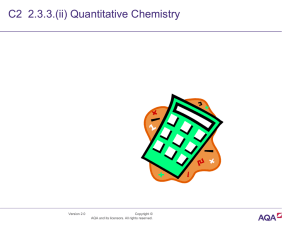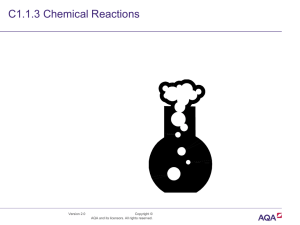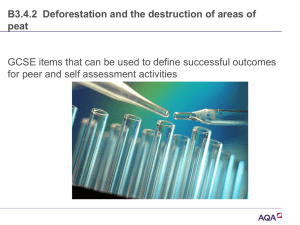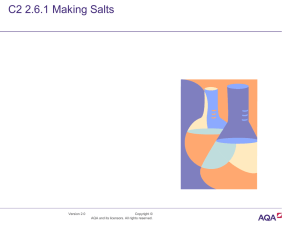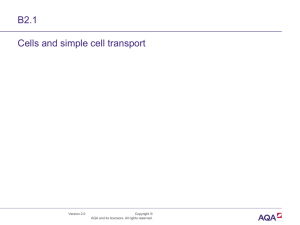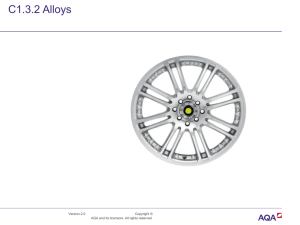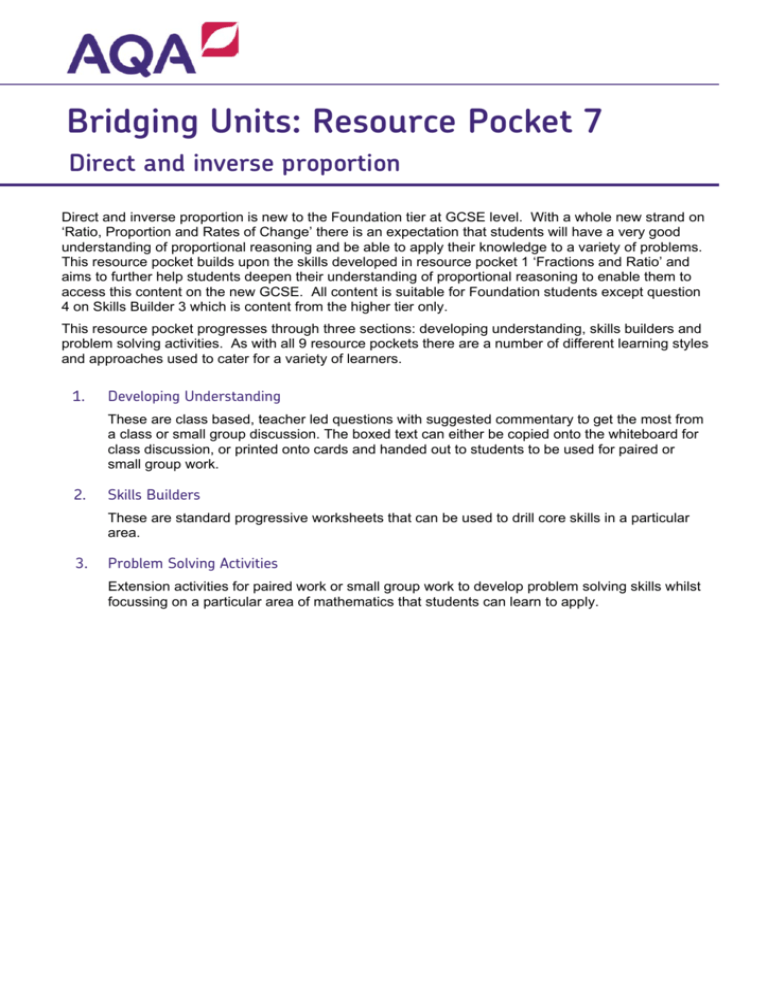
Bridging Units: Resource Pocket 7
Direct and inverse proportion
Direct and inverse proportion is new to the Foundation tier at GCSE level. With a whole new strand on
‘Ratio, Proportion and Rates of Change’ there is an expectation that students will have a very good
understanding of proportional reasoning and be able to apply their knowledge to a variety of problems.
This resource pocket builds upon the skills developed in resource pocket 1 ‘Fractions and Ratio’ and
aims to further help students deepen their understanding of proportional reasoning to enable them to
access this content on the new GCSE. All content is suitable for Foundation students except question
4 on Skills Builder 3 which is content from the higher tier only.
This resource pocket progresses through three sections: developing understanding, skills builders and
problem solving activities. As with all 9 resource pockets there are a number of different learning styles
and approaches used to cater for a variety of learners.
1.
Developing Understanding
These are class based, teacher led questions with suggested commentary to get the most from
a class or small group discussion. The boxed text can either be copied onto the whiteboard for
class discussion, or printed onto cards and handed out to students to be used for paired or
small group work.
2.
Skills Builders
These are standard progressive worksheets that can be used to drill core skills in a particular
area.
3.
Problem Solving Activities
Extension activities for paired work or small group work to develop problem solving skills whilst
focussing on a particular area of mathematics that students can learn to apply.
Developing Understanding 1
To make the perfect blackcurrant drink, mix:
1 part cordial with
4 parts water
Perfect
What will the drink taste like if:
(a)
1.5 parts cordial is mixed with 4 parts water
(b)
1 part cordial is mixed with 3 parts water
(c)
1 part cordial is mixed with 5 parts water
(d)
1 part cordial is mixed with 4 parts water and served over crushed ice
Emphasise the use of consistent language to describe the taste such as strong and weak.
Some questions that would develop a discussion around proportional reasoning could be:
Can you describe the taste if one extra part cordial and one extra part water is added?
Can you explain why?
What about if an extra two parts of both cordial and water is added?
Answers
(a)
strong
(b)
strong
(c)
weak
(d)
weaker as the ice melts
strong
because 4 parts water need adding for every 1 part cordial
this would be even stronger
Copyright © 2015 AQA and its licensors. All rights reserved.
Page 2 of 28
Student’s key misconception here is to believe that as the same amount is being added to (or
subtracted from) the cordial and the water, then the ratios are equivalent. Visually demonstrating can
help students overcome this:
Cordial
Water
1:4
2:5
1.5 : 6
What is being represented in the diagrams above?
Can you create some more?
Create two smiley and two sad diagrams
Copyright © 2015 AQA and its licensors. All rights reserved.
Page 3 of 28
Using only the words
Strong, Weak or Perfect
And comparing to the ‘perfect blackcurrant drink’ describe what the drink will taste
like if cordial and water is mixed in each ratio
Cordial
Water
Taste
1
4
Perfect
2
5
2
8
3
15
3
10
4
16
4
20
When students have completed the table, use the values to reinforce the links between ratios and
fractions. Some possible questions to develop a discussion around this could be:
In the perfect blackcurrant, what fraction of the drink is cordial?
Is this the same fraction for all ‘perfect blackcurrant’ drinks in the table?
Using equivalent fractions, can you write some more ratios for ‘perfect blackcurrant’?
Answers
Cordial
Water
Taste
1
4
Perfect
2
5
Strong
2
8
Prefect
3
15
Weak
3
10
Strong
4
16
Perfect
4
20
Weak
Copyright © 2015 AQA and its licensors. All rights reserved.
1
5
Yes the faction is the same
Some correct fractions and ratios
3
5
could be
(3 : 12),
(5: 20)
25
15
6
(6 : 24)
30
Page 4 of 28
Ella is having a party, she wants to make perfect blackcurrant drink for the guests.
What fraction of the drink will be water?
If Ella wants to make 10 litres of perfect blackcurrant drink, how much cordial does
she need to use?
Answers
4
5
2 litres
Discuss the different ways of calculating the amount.
Ensure students have considered sharing in ratio 1 : 4 and are clear that this is the same as
calculating
1
of 2 litres.
5
If Ella has 5 litres of water, how much cordial does she need to mix it with?
How much perfect blackcurrant drink can she make with
What about if Ella has 400 ml of cordial?
1
litre of cordial?
2
Answers
1.25 litres of cordial for 5 litres of water
2.5 litres of blackcurrant with
2000 ml or 2 litres blackcurrant with 400 ml of cordial
Copyright © 2015 AQA and its licensors. All rights reserved.
1
litre of cordial
2
Page 5 of 28
Developing Understanding 2
SHOP AND CO.
2 BOTTLES OF WATER
4 TUBES OF SWEETS
£0.90
£2.40
TOTAL CHARGE
£3.30
CASH
£10.00
CHANGE
£6.70
Ensure that students understand what the till receipt is showing.
Then discuss what information can be taken from the receipt.
Ask:
How much would 6 tubes of sweets cost?
Answers
£3.60
Discuss the different methods of calculating the cost of 6 tubes.
What would be the cost of 10 tubes?
What would be the total charge for 4 bottles of water and 8 tubes of sweets?
How did you calculate it? Is there a quick way?
What would be the total charge for 1 bottle of water and 2 tubes of sweets?
What would be the total charge for 4 bottles of water and 2 tubes of sweets?
As one quantity has doubled and the other has halved, should the cost stay the same?
If not why not?
Answers
10 tubes = £6
4 water + 8 sweets = £6.60
A quick way is to double the total charge
1 water + 2 sweets = £1.65
4 water + 2 sweets = £3
No it shouldn’t be the same
Because the water and the sweets are different prices
Copyright © 2015 AQA and its licensors. All rights reserved.
Page 6 of 28
Introduce the fact that the number of tubes and the cost of the tubes are directly proportional and ask
students to explain what they think this means.
Using only the information on the till receipt, can you identify anything else that is directly
proportional?
Are the quantity and cost of buying everything directly proportional?
Discuss bulk buying items and that often if you buy a large quantity of one item you can get a
discounted price. Emphasise that in this case the quantity and cost are not directly proportional.
Answers
The number of bottles of water and the cost of the water
No, not everything
Julie’s shop charges £1.30 for 5 rubber ducks
Kieron sells 8 rubber ducks for £2.24
Use the information to discuss who is offering the best value for money:
How much does Julie charge for 1 duck?
How much does Kieron charge for 1 duck?
Who is offering the best deal?
How much would it cost to buy 10 ducks from Kieron?
If Julie decided to match Kieron’s price, how much would she charge for 5 ducks?
Answers
Julie charges 26p for 1 duck
Kieron charges 28p for 1 duck
Julie has the best deal
10 ducks = £2.80
5 ducks at Kieron’s price = £1.40
Copyright © 2015 AQA and its licensors. All rights reserved.
Page 7 of 28
70
0.01462
What could these signs be showing?
Students should quickly realise that the first sign is showing a speed limit of 70 mph.
Ask students:
If it is ok to travel 70 miles in 1 hour, how many hours would it take to travel 1 mile?
The second sign shows 0.014286 hours per mile. (This is 0.857 minutes or 51.429 seconds per mile)
Discuss with students which is the better sign to display on the roads.
Julie’s shop charges £1.30 for 5 rubber ducks
Kieron sells 8 rubber ducks for £2.24
Ask students to calculate:
How many pounds does Julie charge for 1 duck?
How many ducks (exactly) does Julie sell for 1 pound?
Which is the most sensible value to calculate and why?
Explain to students that when working with values that are proportional, it helps to work out a constant.
Here both the number of pounds per duck and the number of ducks per pound provide us with a
constant, but the unit price is the easiest to use.
Answers
£0.26 for 1 duck
3.8 ducks for £1
The number of pounds per duck
Copyright © 2015 AQA and its licensors. All rights reserved.
Page 8 of 28
Sally works in a café.
To earn £60 she must work 8 hours.
Kamran works in the same café.
After a 5 hour shift, he earns £39.
Ask students to think of different ways that they could compare the earnings of Sally and Kamran.
What are the two unit values that can be compared?
Which is the most sensible to use?
Can you explain why?
Calculate this for Sally’s earnings
Calculate this for Kamran’s earnings?
What do your findings show?
Make comparisons using the number of hours work to earn £1.
Does this confirm or contradict your findings?
Answers
The two unit values are pounds per hour and hours per pound
The most sensible is pounds per hour
Because we normally work a whole number of hours, or any other valid reason
Sally’s rate per hour is £7.50
Kamran’s rate per hour is £7.80
Kamran earns a higher rate than Sally
Sally must work 0.13333.. hours per pound, Kamran must work 0.128 hours per pound, so
Kamran has the better rate as he has to work less per pound
This confirms that Kamran earns a higher rate
Copyright © 2015 AQA and its licensors. All rights reserved.
Page 9 of 28
Developing Understanding 3
Freddie is building an extension on his house.
It will take him 40 days to complete if he works alone.
He would like the extension completed in 7 days.
Is it possible?
If so, how?
Encourage students to think about how long it would take if Freddie had somebody to help him.
Some questions to ask:
How long would it take if two people were building the extension?
What about more than two people?
What assumptions are being made?
Explain that if certain assumptions are made, then the number of workers and the number of days to
complete the job are inversely proportional.
Here the constant is the number of days for ONE worker, 40 days.
Answers:
Answers
2 people = 20 days
eg 4 people = 10 days
Assuming that all workers work at the same speed
Copyright © 2015 AQA and its licensors. All rights reserved.
40
Page 10 of 28
Claire wants to arrange a minibus to take a group of friends to a party.
The minibus can hold 25 passengers.
The cost for hiring the minibus is £125.
This will be shared equally between the passengers.
(a)
If there are 20 passengers, what fraction must they each pay?
(b)
If there are 20 passengers going to the party, how much do they each
have to pay for the minibus?
(c)
If each passenger must pay
of £125
How many passengers are going to the party?
Explain that the number of passengers and the cost per person are inversely proportional. Ask
students if they can explain what this means to their partner.
What affect does the fact that the minibus can hold 25 passengers have?
As the number of passengers increases, the cost per person decreases.
Here the constant is the cost if there is ONE passenger, £125.
Answers
1
20
£6.25
12
Copyright © 2015 AQA and its licensors. All rights reserved.
125
Page 11 of 28
An amount of British pounds is related to the same amount in US dollars.
The graph shows this relationship.
British
Pounds
(£)
US Dollars ($)
Ask students what they can see from the graph.
Can you see from the graph how many US Dollars have the same value as £60?
How many pounds could you get for $50?
Is the graph any use if I want to convert £100 into US Dollars?
Ask the students if they think British pounds and US Dollars are proportional? If so, are they directly or
inversely proportional? And why?
From the previous examples, students should understand that the two are directly proportional because
as one increases, the other increases by the same proportion.
Answers
£60 = $90
$50 = £34
Yes £50 = $75 so £100 = $150
Copyright © 2015 AQA and its licensors. All rights reserved.
Page 12 of 28
Skills Builder 1: Direct proprtion
Section A
For each statement calculate each unit value, then circle which is the most sensible to use.
The first one has been done for you.
1
8 books cost £9.60
8 books = £9.60
8 books = £9.60
÷8
÷8
÷8
= £1
1 book =
£1.20 per book
2
0.833 books per £1
In 12 hours a bricklayer laid 1500 bricks
12 hrs = 1500 bricks
12 hrs = 1500 bricks
÷ 12
÷12
1 hr
÷ 12
÷12
= 1 brick
bricks per hr
3
÷8
hrs per brick
A heart beats 280 times in 4 minutes
minutes per beat
Copyright © 2015 AQA and its licensors. All rights reserved.
beats per minutes
Page 13 of 28
4
Bernie can type 150 words in 5 minutes
5
£8 is equal to €10.50
Copyright © 2015 AQA and its licensors. All rights reserved.
Page 14 of 28
Section B
1
Sam pays £1 for 4 chocolate bars.
How much would 7 chocolate bars cost?
2
Lucy earns £24.50 for 3.5 hours work.
How much will she earn for 10 hours work?
3
Elsa takes 2 days to paint 3 rooms.
How long will it take to paint 5 rooms of the same size?
4
Aliyah makes 5 loom bracelets in 15 minutes.
How many bracelets can she make in an hour?
5
Terry the Clown can make 12 balloon animals in 2 minutes.
He needs to make balloon animals for 30 children.
How long will it take him?
Section c
1
Four students took IQ tests.
Each student was asked a different number of questions.
Their results are as follows:
Simon answered 8 questions correctly out of 10
Selina answered 9 questions correctly out of 12
Jimmy answered 6 questions correctly out of 9
Fran answered 4 questions correctly out of 6
Which student performed the best in their IQ test?
2
Which is the best value:
500 g of sweets for £3.75 or
800 g of sweets for £5.50 ?
Copyright © 2015 AQA and its licensors. All rights reserved.
Page 15 of 28
3
Ani drove 400 miles on 80 litres of petrol.
Xavier drove 360 miles on 60 litres of petrol.
Who drives the most fuel efficient car?
4
A shop has 2 offers:
18
toilet rolls
for £8
12
toilet rolls
for £6
Which is the better value?
5
Band A and Band B are both playing at the AQA Arena.
The Arena has a capacity of 40,000 people.
Band A sold out in 9 days.
After 5 days of ticket sales, Band B has sold 26,000 tickets.
Assuming that Band B will continue to sell tickets at the same rate, will they sell out quicker than
Band A?
Justify your answer.
Copyright © 2015 AQA and its licensors. All rights reserved.
Page 16 of 28
Sills Builder 2 : Direct and Inverse
Proportion
1
Using the information in the centre, complete each diagram.
Use the two empty boxes to make up your own statements.
(a)
There are 1640 calories
in _________
chocolate bars
5 chocolate bars
contain _________
calories
3 chocolate bars contain
615 calories
In _________
chocolate bars there
are 410 calories
10 chocolate bars
contain _________
calories
Copyright © 2015 AQA and its licensors. All rights reserved.
Page 17 of 28
(b)
It takes 3 days
for _________
farmers to plough
the field
1 farmer can plough
the field in
_________ days
i
2 farmers can plough
a field in 6 days
It will take _________
farmers 4 days
to plough the field
18 farmers can
plough the field
in _________ days
Copyright © 2015 AQA and its licensors. All rights reserved.
Page 18 of 28
2
If 6 magazines cost £7.20.
How many magazines can you buy for £12?
3
4 builders can build a house in 20 days.
How long would it take 1 builder?
4
3 painters can paint a fence in 5 hours.
How long would it take 2 painters?
5
350 parcels are sent into 3 vans for delivery.
The first van contains twice as many parcels as the second van.
The third van contains twice as many parcels as the first van.
How many parcels are in each van?
6
Richard is organising his DVDs into three categories.
The comedy category has 10 more DVDs than the Action category.
The Animated category has twice as many DVDs as the Comedy category.
If Richard has 110 DVDs altogether, how many of each category does he have?
7
Eamon buys two bottles of shampoo and a bottle of conditioner.
He pays at the till and receives 80 pence change from £5.
If the conditioner was 1.5 times the cost of the shampoo,
how much was the conditioner?
Copyright © 2015 AQA and its licensors. All rights reserved.
Page 19 of 28
Skills Builder 3 : Graphs
1
The number of bottles of shampoo is directly proportional to the cost.
3 bottles of shampoo cost £5.40.
(a) How much would 5 bottles of shampoo cost?
(b) On the grid below, draw a graph to represent the relationship between the number of
bottles and the cost.
Cost (£)
Number of bottles
Copyright © 2015 AQA and its licensors. All rights reserved.
Page 20 of 28
2
The wage Jess earns is directly proportional to the number of hours she works.
Her wage is £108 when she works 12 hours.
(a) Draw a graph to represent the relationship between Jess’s wage and the number of hours
she works.
Wage
(£)
Number of hours worked
(b) Use the graph to work out how much Jess’ wages will be if she works 4 hours.
(c)
Use the graph to work out how many hours Jess has worked if her wage is £144.
(d) Read some more values from the graph and use them to write two sentences.
Copyright © 2015 AQA and its licensors. All rights reserved.
Page 21 of 28
3
The graph shows the relationship between pounds and euros.
(a)
Explain why the graph shows
that pounds and euros are
directly proportional.
(b)
Use the graph to work out
how many euros is
equivalent to £40
(c)
Use the graph to work out
how many pounds is
equivalent to €180
(d)
Explain how you could use
the graph to work out how
many euros is equivalent to
£1000.
£
€
4
The points plotted on the grid below represent the number of people at a Christmas lunch and the
cost per person.
Cost
per
person
(£)
(a)
Join the points with a smooth
curve to create the graph.
(b)
Does this graph show direct
proportion or inverse
proportion?
(c)
Use the graph to calculate
the cost per person when
14 people attend.
Number of people
Copyright © 2015 AQA and its licensors. All rights reserved.
Page 22 of 28
Problem solving 1 : Ratios and Fractions
Print and cut out the cards
Give one set to each pair or group of students.
The instructions are contained within one of the cards, so no teacher guidance is required.
How much change will
James get from £20?
The ratio of the cost of an
apple to the cost of a melon is
1:8
the cost of a melon
James buys 6 apples, 1 melon
50g of grapes and
2 bottles of water
4 apples cost
84p
8 bottles of water cost
£3.60
At the checkout, James
hands in a voucher giving
him 15% off the total
James goes shopping at
his local farm shop
100g of grapes cost
Copyright © 2015 AQA and its licensors. All rights reserved.
2
of
3
Page 23 of 28
Print and cut out the cards
Give one set to each pair or group of students.
The instructions are contained within one of the cards, so no teacher guidance is required.
A community hall needs painting.
Two local decorating companies are available to do the work.
Using the information on the cards, work out which company each
painter works for, and decide which company can paint the hall the
quickest.
Painters R Us is a decorating
company that has 4 painters.
Each painter works at the same
speed.
Décor and Co is a decorating
company that has 4 painters.
Each painter works at the same
speed, this speed is faster than
the painters at Painters R Us
Alfie and Cal work for the same
company. Together they could
paint the hall in exactly 3 hours
Evan can paint the hall in exactly
8 hours
Billy and Hans work for the same
company, together they could
paint the hall in exactly 4 hours
Dev and Frank do not work for
the same company. Together
they would take more than 3
hours but less than 4 hours to
paint the hall
Evan and Ged work for different
companies. Together they would
take less than 4 hours to paint
the hall
Frank works for the same
company as Ged
How long would it take all
painters from Painters R Us to
paint the hall together?
How long would it take all
painters from Decor and Co to
paint the hall together?
Copyright © 2015 AQA and its licensors. All rights reserved.
Page 24 of 28
Answers
Skills builder 1
Section A
1
£120 per book
0.8.33 books per £1
125 bricks per hour
1
hours per brick
125
1
minutes per beat
70
70 beats per minute
30 words per minute
1
minutes per word
30
€1.3125 per £1
£
2
3
4
5
16
per €1
21
(either circled)
Section B
1
£1.75
2
£70
3
3
1
days
3
4
20
5
5 minutes
Copyright © 2015 AQA and its licensors. All rights reserved.
Page 25 of 28
Section C
1
Simon = 80%, Selina = 75%, Jimmy = 67%, Fran = 67%
Simon performed the best.
2
500g = 75p per 100 g, 800 g = 69p per 100 g
800g for £5.50 is the better value.
3
Ani = 50 miles per 10 litres, Xavier = 60 miles per 10 litres
Xavier has the most fuel efficient car.
4
18 rolls = £2.67 for 6, 12 rolls = £3 for 6.
18 for £8 is the better value.
5
Band B will sell out in 8 days.
Yes they will sell out quicker.
Skills builder 2: Direct and Inverse Proportion
1
8
1025
2
2050
Copyright © 2015 AQA and its licensors. All rights reserved.
Page 26 of 28
2
4
12
3
1.5
2
10
3
80 days
4
7.5 hours
5
Van 1 = 100, Van 2 = 50, Van 3 = 200
6
Comedy = 30, Action = 20, Animated = 60
7
£1.80
Copyright © 2015 AQA and its licensors. All rights reserved.
Page 27 of 28
Skills builder 3: Graphs
1
2
3
4
(a)
£9
(b)
straight line through (0, 0) and (3, 5.4)
(a)
straight line through (0, 0) and (12, 108)
(b)
£36
(c)
16 hours
(a)
straight line through the origin
(b)
€60
(c)
£120
(d)
convert £100 then multiply by 10
(a)
smooth curve through the points
(b)
inverse proportion
(c)
accept between £6 and £8
Problem solving 1: Ratios and Fractions
1 apple = 21p
1 melon = £1.68
50 g grapes = 56p
1 water = 45p
James’ total bill = £3.74 after the discount.
His change will be £16.26
Problem Solving 2: Ratios and Fractions
Alfie = 6 hours
Billy = 8 hours
Cal = 6 hours
Dev = 8 hours
Evan = 8 hours
Frank = 6 hours
Ged = 6 hours
Hans = 8 hours
Painters R Us staff are: Billy, Dev, Evan and Hans
Décor and Co staff are: Alfie, Cal, Frank and Ged
Painters R Us would take 2 hours to paint the hall
Décor and Co would take 1.5 hours to paint the hall.
Décor and Co could paint it quicker.
Copyright © 2015 AQA and its licensors. All rights reserved.
Page 28 of 28

